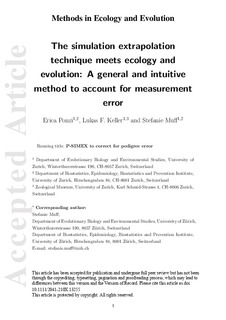The simulation extrapolation technique meets ecology and evolution: A general and intuitive method to account for measurement error
Journal article, Peer reviewed
Accepted version

Åpne
Permanent lenke
http://hdl.handle.net/11250/2618728Utgivelsesdato
2019Metadata
Vis full innførselSamlinger
- Institutt for matematiske fag [2397]
- Publikasjoner fra CRIStin - NTNU [37703]
Originalversjon
10.1111/2041-210X.13255Sammendrag
1. Measurement error and other forms of uncertainty are commonplace in ecology and evolution, and may bias estimates of parameters of interest. Although a variety of approaches to obtain unbiased estimators are available, these usually require the formulation of an explicit (parametric) model for the error‐prone variable and a latent model for the unobserved (latent) error‐free variable. In practice, this is often difficult.
2. We propose to generalize the simulation extrapolation (SIMEX) technique, a heuristic approach to correct for measurement error, to situations where it is difficult to explicitly formulate an error model or latent model for a variable of interest. We illustrate the idea with the example of error in pedigrees. Pedigree error causes error in estimates of inbreeding coefficients and the relatedness matrix, thus biasing estimates of inbreeding depression or heritability. Instead of formulating error models for inbreeding coefficients or the relatedness matrix, we directly apply the SIMEX idea to the pedigree. The initially known error proportion in the pedigree is progressively increased, all models are refitted, and the observed trend in the quantities of interest is extrapolated back to a hypothetical error‐free pedigree to obtain bias‐corrected estimates. We tested this pedigree‐SIMEX (PSIMEX) method with simulated pedigrees and with data from a free‐living population of song sparrows.
3. The simulation study indicates that the PSIMEX estimator is almost unbiased for inbreeding depression and heritability, and that it has a much lower mean squared error (MSE) than the naive estimator. In the application to the song sparrows, the error‐corrected results could be validated against the actual values thanks to the availability of both an error‐prone and an error‐free pedigree. The results indicate that bias and MSE are reduced by PSIMEX. For easy accessibility of the method, we provide the R‐package PSIMEX.
4. By transferring the SIMEX philosophy to error in pedigrees, we have illustrated how this heuristic approach can be generalized to situations where explicit error models are difficult to formulate. Thanks to the simplicity of the idea, many other error problems in ecology and evolution might be amenable to SIMEX‐like error correction methods.